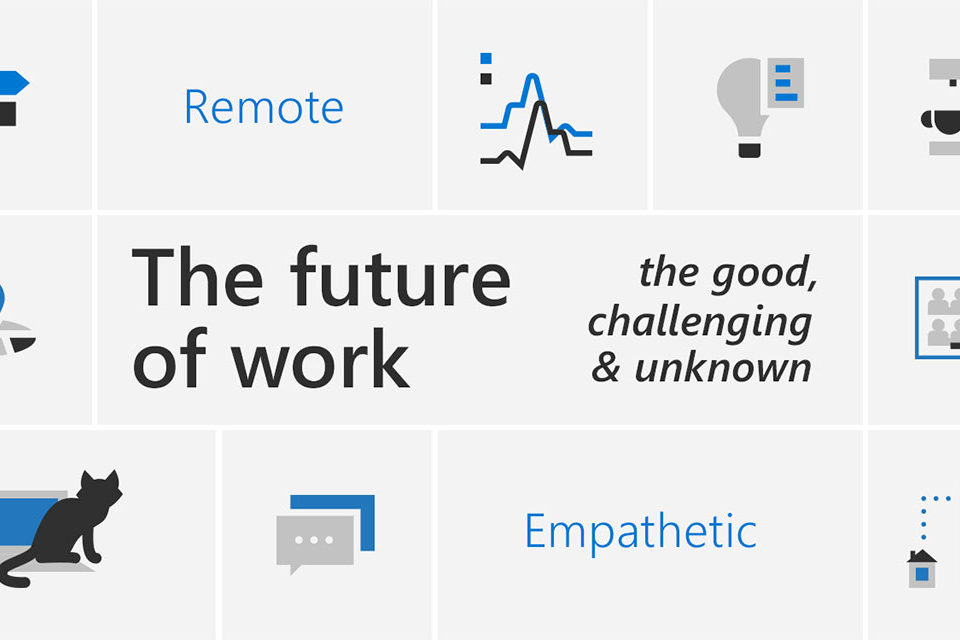 How the sudden global shift to telecommuting may have changed the world of work forever The world of
How the sudden global shift to telecommuting may have changed the world of work forever The world of
work has changed dramatically over the past four months. But will these changes continue in the future? In our second Work Trend Index report, we explore this idea using data from three sources: trends showing how our customers are using our tools; the results of the Harris Poll survey of more than 2,000 telecommuters in six countries; and findings from over 30 Microsoft research projects that analyze the experiences of telecommuters using tools such as surveys, interviews, diary research, focus groups, and brain reactions.
Our goal in this study is to uncover both the positive and negative aspects of teleworking so that we can accelerate product development in the right direction, predict how the world will change in the future, and help our customers thrive in the new world. Below are four main findings.
Electroencephalograms show: online meetings are really tiring
A widely discussed bottleneck in telecommuting is that it can feel harder and more tiring than meetings in person. Researchers at Human Factors Labs recently studied this phenomenon. Do telecommuting and video conferencing really tire our brains more than face-to-face work? The brain answers: yes.
Remote collaboration is harder, but getting back to office work can be just as difficult
In one study, 13 teams of two were asked to complete similar tasks together - once in person and once remotely. The study participants had special EEG devices that track changes in brain waves. The study found that telecommuting is much more difficult for the brain than face-to-face meetings. In particular, the brain wave patterns that are associated with stress and overwork were much higher with remote collaboration than with face-to-face collaboration. But there were also unexpected findings: if the couple initially collaborated remotely, brain waves showed that it was more difficult for them to work together in person after that. It seems that social connections and work strategies created through face-to-face collaboration are then used in remote collaboration, and vice versa.As a result of the study, two important conclusions were drawn. In a world that is shifting to teleworking, people find telecommuting more difficult psychologically. But on top of that, when the pandemic recedes and people start working more together in person again, it can also seem more difficult than it was before Covid-19.
A second study found that markers of brain activity associated with overwork and stress are significantly higher during video conferencing than when working outside of online meetings, such as writing emails. Moreover, due to the high level of sustained concentration, fatigue occurs 30-40 minutes after the start of the conference. And if there are several videoconferences during the day, stress occurs about two hours after the start of the working day. Research has identified several factors that cause this conference fatigue: the need to constantly focus on the screen to get information and stay on; a decrease in the number of non-verbal cues that help to take into account the situation or understand whose turn it is to speak; little opportunity to see other participants when the screen is shown.

To alleviate the situation, we recommend taking regular breaks every two hours so that your brain can reboot, limit meeting times to 30 minutes, or take short breaks whenever possible during long meetings.
To help address these challenges with our technology, we also released a series of Teams updates today to help you feel more connected with your colleagues and be less tiring during meetings. Two of them are Together mode and Dynamic view.
Together mode is a new conferencing mode in Teams that uses AI-powered segmentation technology to put participants in a shared background. Thanks to this look, you get the feeling that you are in the same room. This helps reduce distractions, track non-verbal cues, and communicate more naturally. This is a very convenient mode for brainstorming or round-table discussions when several people are speaking. Early research using biosensors that measure brain activity showed that the brain exerts less effort when a person is participating in a Together mode meeting than when using grid mode. Consequently, Together mode helps telecommuters work less.
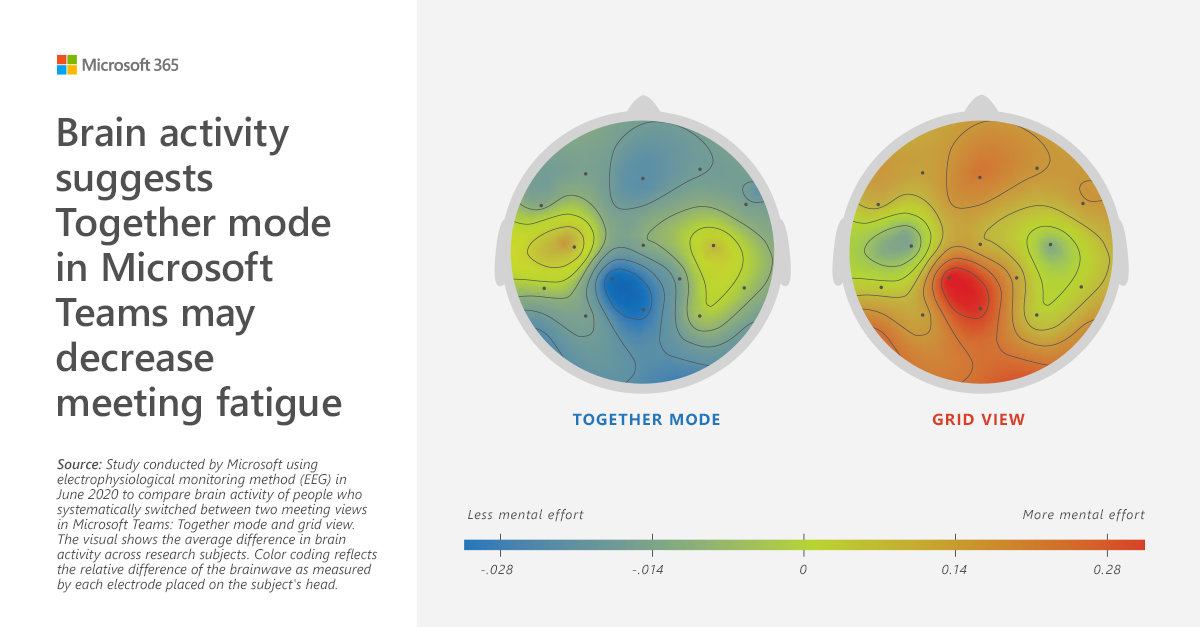
Dynamic view (dynamic view). We've also created a set of enhancements to traditional Teams to make conferences more engaging. AI now helps to dynamically optimize the streaming of shared content and participant videos. New management tools let you personalize the look according to your preferences and needs. In particular, you can now show shared content and specific participants on the same screen, or reduce the size of the shared content window to see more of the participants you are speaking to.
Other findings
- The pandemic may have changed work culture forever
- The working day "from 9 to 17" can sink into oblivion
- Physical offices won't disappear in the future
The pandemic may have changed the culture of work forever
The idea that current unique circumstances have accelerated the process of merging work and life - which may have softened the dynamics of jobs forever - is recurrent in all research.
More than half of the parents surveyed (54%) reported that it was difficult to balance household chores and work from home. This burden turned out to be the most difficult for millennials - representatives of this generation today form the basis of the US labor force, as well as for new entrants to the labor market - generation Z. Perhaps this is due to the fact that in families of this age group, children are younger or they live with neighbors around the room and work full day.

“When there are four family members in the house at the same time, it can be difficult to find a separate space for yourself,” - an information technology specialist.
While the experience of combining childcare with telecommuting was often temporary, it could change how we feel about our colleagues in the long run. 62% of study participants reported that they feel more empathy for their colleagues now, having a better idea of what it means to be at home all the time. This was particularly evident in China and Mexico, where 91% and 65% of study participants, respectively, reported feeling more empathy.
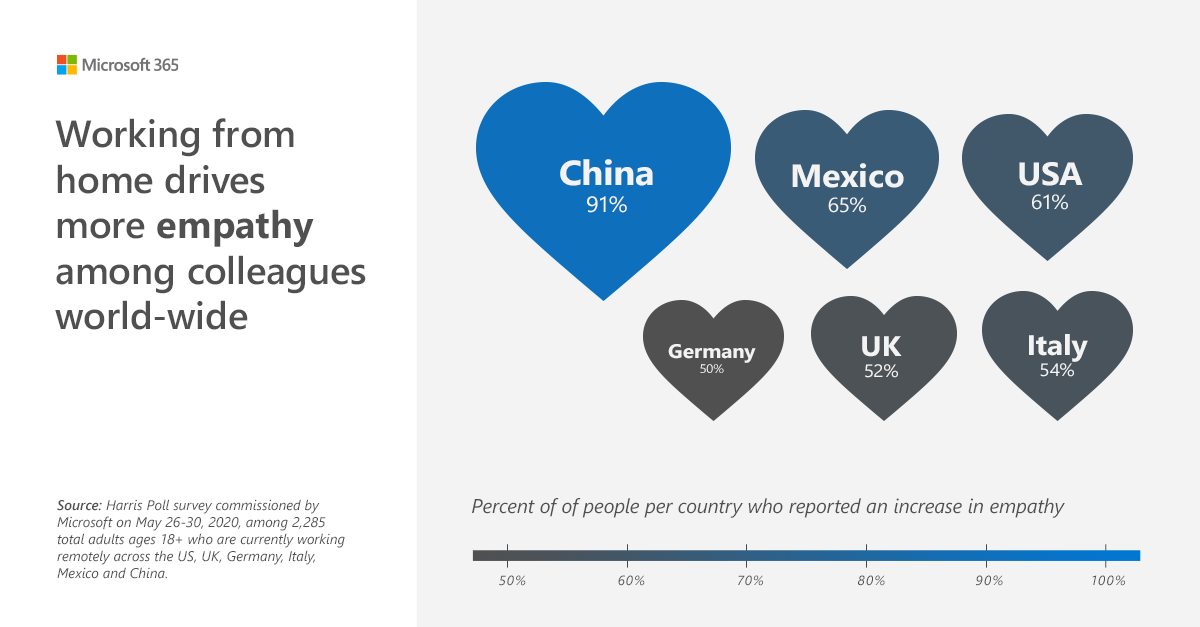
« . . , , », — .
In some cases, shifting to remote work can also increase inclusiveness. More than half (52%) of the respondents felt that they were appreciated more and felt that they were included as conference participants, because now everyone was in the same virtual room. This feeling was most pronounced in China (65%) and Germany (57%). We also saw that conference chats have become a way for many people to share their point of view. In particular, the number of messages in chats in Teams conferences has grown by more than 10 times between March 1 and June 1.
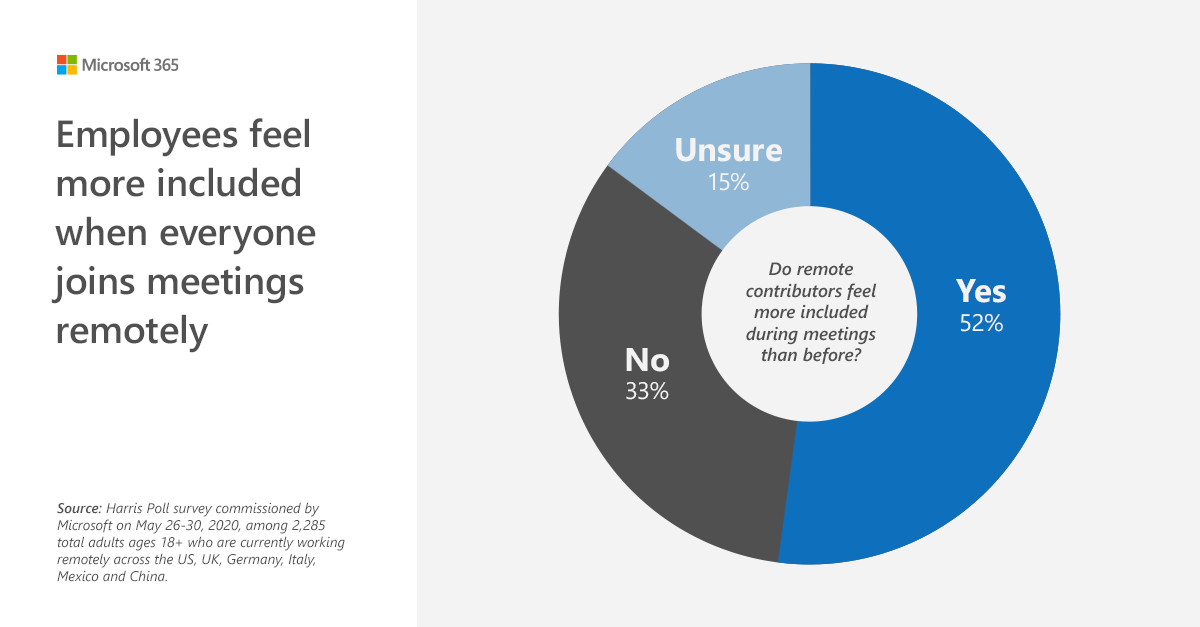
“Remote workers used to be invisible, but now they are not,” - IT specialist.
The working day from 9 to 17 can sink into oblivion
In our latest report Between March 1 and March 31, we saw that the average time between the first and last use of Teams during the day increased by one hour. In the report, we explore this question in detail: is the 5-day work week with a schedule from 9 to 17 really going into oblivion soon? The data confirms this. In Teams, people work more often in the mornings and evenings, and on weekends too. Teams chat volumes between 8:00 am and 9:00 am and 6:00 pm-8:00 pm grew more than the rest of the day, by 15% and 23%, respectively. People also work harder on weekends, with Teams chats growing by over 200% on Saturdays and Sundays.
“With more flexible working hours, we can be more productive. I can take breaks and not feel guilty, ”- information technology specialist.
“My working day is getting longer ... This is reality. We were in touch before, but now our laptops are sitting with us at the kitchen table, and everyone needs to be constantly updated, ”- an information technology specialist.
To help our customers better manage their time in this new environment, we've added focus status to Teams , which tells your team that you need to set aside time to focus on your calendar. You can also highlight calm hours and calm days.to turn off reminders in Teams when you need it. In the coming weeks, we'll be releasing the Reflect Teams messaging extension, a simple way to connect with your team on topics like work-life balance. It contains customizable test questions covering a variety of topics and designed to assess the emotional well-being of a team. Answers can be shared with the rest of the team, or you can keep them anonymous.
This fusion of life and work seems to be a long-term trend, and technology can help alleviate some of the difficulties associated with it. We'll talk about what else we are doing in the area of organizational analytics and employee well-being in the near future.
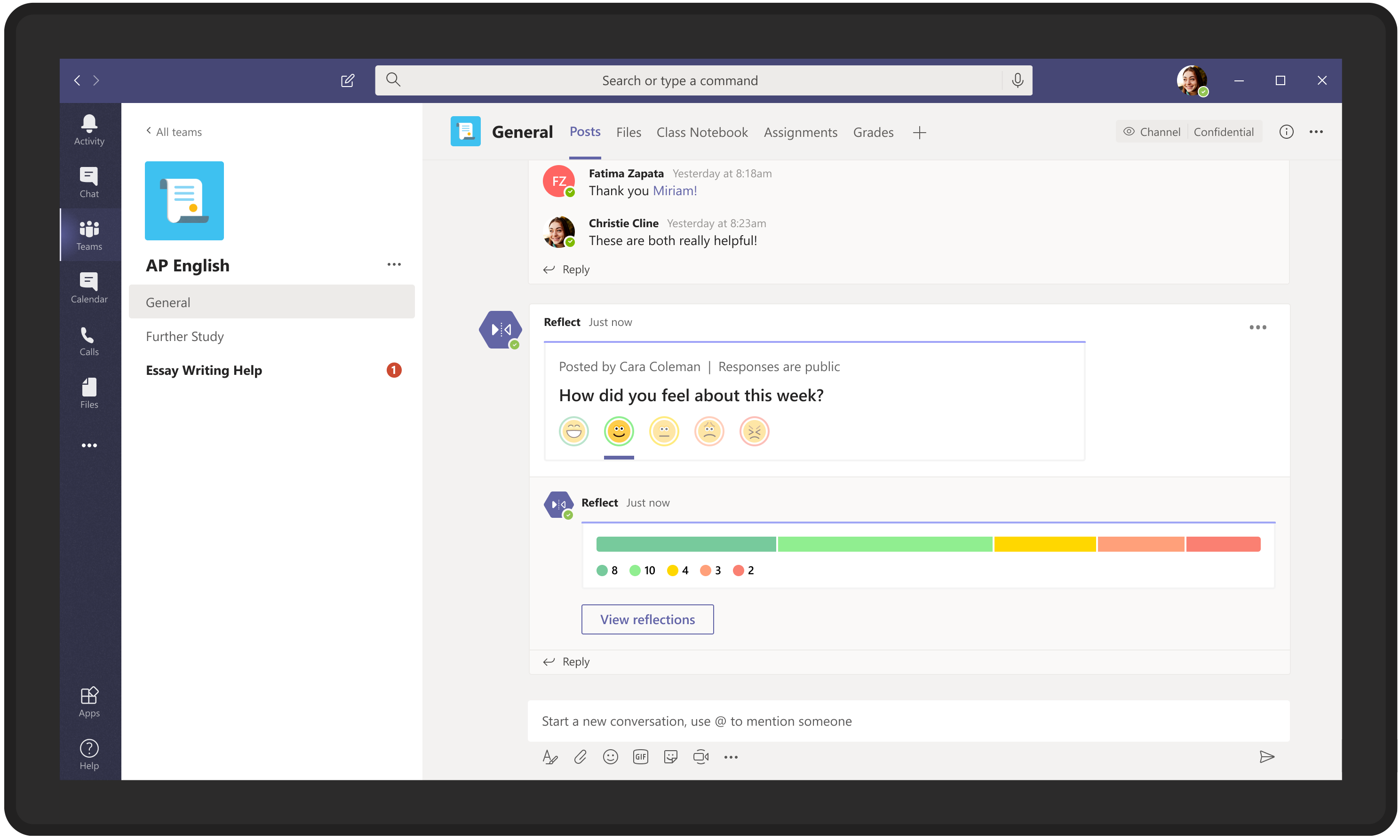
Physical offices won't disappear in the future
Many employees around the world have spent the past four months working remotely at least part of their time. As teams adapted to the new reality, people began to wonder if physical offices would disappear in the future. Our research shows that it is likely that face-to-face and remote collaboration is likely to be combined in a typical work schedule.
For example, 82% of executive respondents said they started taking a more flexible approach to working from home after the pandemic. In a broader context, 71% of employees and managers reported wanting to continue working at least partially from home. Participants of our focus groups expressed a similar opinion.
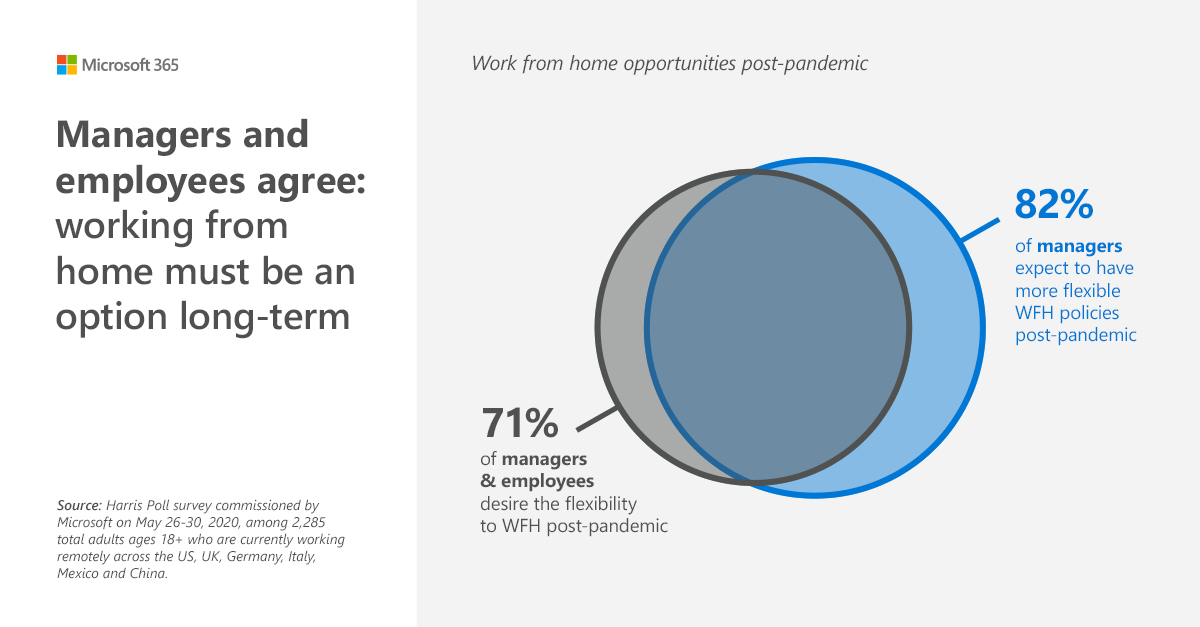
“Before, when the boss didn’t see you, it meant that you weren’t working ... But if you successfully cope with your tasks, it should not matter where you do it”, - the head of the enterprise.
However, our research has identified several problems associated with working from home. About 60% of survey participants often feel insufficiently included in the life of the company, working remotely. For China, this figure reached 70%.
In addition, only 35% of respondents in one of the studies have a dedicated home office. And only 5% of the Harris Poll survey respondents live alone. It is therefore not surprising that distractions, communication problems, and a lack of ergonomic work tools were highlighted in our study as major pain points in telecommuting. This shows that while people will start to work far more remotely in the future than before, physical office space, with its benefits of ergonomic internet-connected workspaces, opportunities for networking with colleagues and teamwork, is likely to remain a key part of the world of work.
« , . , », — .
«, - , , Wi–Fi», — .
Overall, this global shift to teleworking has revealed both new opportunities and pain points for the future of work. On the plus side, in these unique circumstances, where the entire family worked and studied from home, there was more empathy among colleagues. In addition, both employees and managers began to understand that working remotely was possible. It also made the world of work more inclusive for telecommuters.
Difficulties include the fact that telecommuting tends to mean longer work schedules, increased fatigue in meetings, and a lack of interpersonal connections such as spontaneous conversations in the hallway to help strengthen the team and facilitate collaboration. The lack of a convenient, Internet-connected workspace at home remains a problem for most of us.
At Microsoft, we are uniquely positioned to help our customers get the most out of their opportunities while addressing the issues that arise. We hope you will see that as the labor market evolves, so does our tools - and in this unique era of rapid change, we continue to fulfill our mission to help every person and every organization on the planet achieve more.
Microsoft . , , , . , , , , . — , Microsoft Graph, .